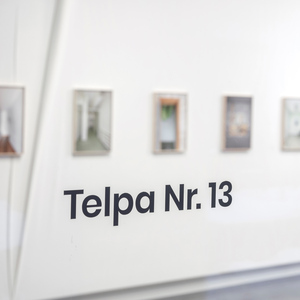Reinis Hofmanis: Telpa Nr.13 / Room No.13
No 17. novembra līdz 26. janvārim ISSP Galerijā ir skatāma fotogrāfa Reiņa Hofmaņa personālizstāde “Telpa Nr.13”. Tajā būs aplūkojama daudzu gadu garumā radīta fotogrāfiju sērija, kurā autors pievērsies dažādu, lielākoties mums apslēptu telpu vizuālai izpētei.
From November 17 until January 26 the solo exhibition Room No.13 by Latvian photographer Reinis Hofmanis is on view at the ISSP Gallery. The exhibition feature a collection of photographs taken over the span of several years exploring the visuality of various, mostly hidden spaces.
LV
“Telpa Nr.13” ir Reiņa Hofmaņa trīspadsmitā personālizstāde. Industriālo ēku tehnoloģiskās telpas, dažādu materiālu glabātuves un krātuves, sen pamestas vai, tieši pretēji, mūsdienām pielāgotas telpas no trīsdimensionālas pieredzes pārtapušas vizuāli tīkamos divdimensiju attēlos. Līdz ar fotogrāfijās redzamo pieklusināto estētiku, tajās jaušama nepārprotama cilvēka un vides mijiedarbība laikā – savulaik tumšajos simtgadīgo ēku pagrabos nu ir iemiesojušies kanalizāciju vai elektrotīklu artefakti.
“Senāk tā bija ainava, kurā jūtama cilvēka ietekme, kādas nepareizības tajā ienestas. Pēdējos gados tas ir interjers, cilvēka veidota un ietekmēta telpa,” par darbu kontekstu stāsta Reinis Hofmanis. “Sastopoties funkcionālajai un estētiskajai domāšanai, telpa laika gaitā evolucionē, tiek pielāgota jaunām funkcijām un jauniem dzīves standartiem. Vadi, caurules, siltinājuma un iekārto griestu slāņi tiek iemānīti telpās, kuras būvējot tie nav pastāvējuši. Telpu arhitektūra un komunikāciju izvietojums var šķist pat absurds, tomēr tajā pastāv iekšēja loģika un savdabīga estētika.”
Šīs arhitektūras terminoloģijā dēvētās komunikācijas Reiņa fotogrāfijās ir kļuvušas par savdabīgu cilvēka un vides attiecību metaforu. Tomēr tās nav attiecības, kas veidojas uz personiskas un intīmas pieredzes bāzes, piemēram, domājot par mūsu bērnības mājām. Gluži pretēji – fotogrāfa iemūžinātajās telpās ir grūti iedomāties patīkamu ķermenisku vai garīgu pieredzi, tomēr tās atklāj cilvēka vēlmi pielāgot, uzlabot un, galu galā, pieškirt telpai jēgu. Pat, ja šī jēgas izpratne nesniedzas tālāk par salātzaļu krāsu uz sienas.
Izstādes scenogrāfiju un telpiskos risinājumus veido mākslinieks Aleksejs Beļeckis. Izstādes kuratore – Iveta Gabaliņa.
Reinis Hofmanis (1985) ir mākslinieks un fotogrāfs. Studējis fotogrāfiju Lietišķo Zinātņu un Mākslas universitātē Hannoverē, Vācijā, un ieguvis maģistra grādu Latvijas Mākslas akadēmijas Vizuālās komunikācijas nodaļā. Reiņa darbus raksturo sociālantropoloģisks skatījums, kas izpaužas interesē tipoloģizēt dažādas sabiedrības grupas, to uzvedības modeļus un radīto vai ietekmēto vidi. Ieguvis galveno balvu Archifoto 2012. un 2013. gadā, saņēmis 2. vietu Sony World Photography Awards Arhitektūras kategorijā. Viņa darbi ir publicēti tādos izdevumos kā New York Times, Financial Times, Spiegel, Esquire, Bloomberg, Le Monde, The Globe and Mail, The British Journal of Photography.
Izstāde “Telpa Nr.13" norisinās ar Rīgas domes, Valsts kultūrkapitāla fonda un Groglass atbalstu.




ENG
Room No.13 is the 13th solo exhibition by Reinis Hofmanis. The technical spaces of industrial buildings, warehouses for various materials, rooms long abandoned or, on the contrary, adapted for contemporary use, have been transformed from a three-dimensional experience into visually pleasing two-dimensional images. Along with the muted aesthetics of the photographs, they also demonstrate an unmistakably temporal interaction between man and the environment: artefacts of sewers or electrical networks have now embodied the dark basements of hundred-year-old buildings.
"Before, it was the landscape in which human influence and inflicted wrongs could be felt. In recent years, it is the interior – a space created and affected by man,” says Reinis Hofmanis about the context of the artworks. "When functional and aesthetic thinking meet, the space evolves over time and becomes adapted to new functions and new living standards. Layers of wires, pipes, insulation and ceiling fixtures are squeezed into spaces where they have never existed before. The architecture of the space and the placement of an utility infrastructure may even seem absurd, but there is an internal logic and a unique aesthetic to it."
In the images created by Reinis, the utility infrastructure has become a unique metaphor for the relationship between man and the environment. However, these are not relationships that are formed on the basis of a personal and intimate experience, as in the case of our childhood homes, for example. On the contrary, it is difficult to imagine a pleasant physical or mental experience in the spaces captured by the photographer, although they reveal the human desire to adapt, improve and, ultimately, give meaning to the space. Even if this understanding of meaning does not extend beyond painting walls a lettuce-green colour.
The scenography and spatial solutions of the exhibition are created by artist Aleksejs Beļeckis. Curator – Iveta Gabaliņa.
Reinis Hofmanis (1985) is an artist and photographer. He studied photography at the University of Applied Sciences and Arts in Hannover, Germany, and obtained a master's degree from the Visual Communication Department of the Art Academy of Latvia. The artist’s works are characterised by a socio-anthropological point of view, which manifests in an interest in typifying different groups of society, their behavioural patterns and effect on the surrounding environment. Reinis received the main prize at Archifoto in 2012 and 2013, and 2nd place in the Architecture category of the Sony World Photography Awards. His works have been featured in publications such as the New York Times, Financial Times, Spiegel, Esquire, Bloomberg, Le Monde, The Globe and Mail, The British Journal of Photography.
The exhibition Room No.13 is supported by Riga City Council, the State Cultural Capital Foundation and Groglass.







